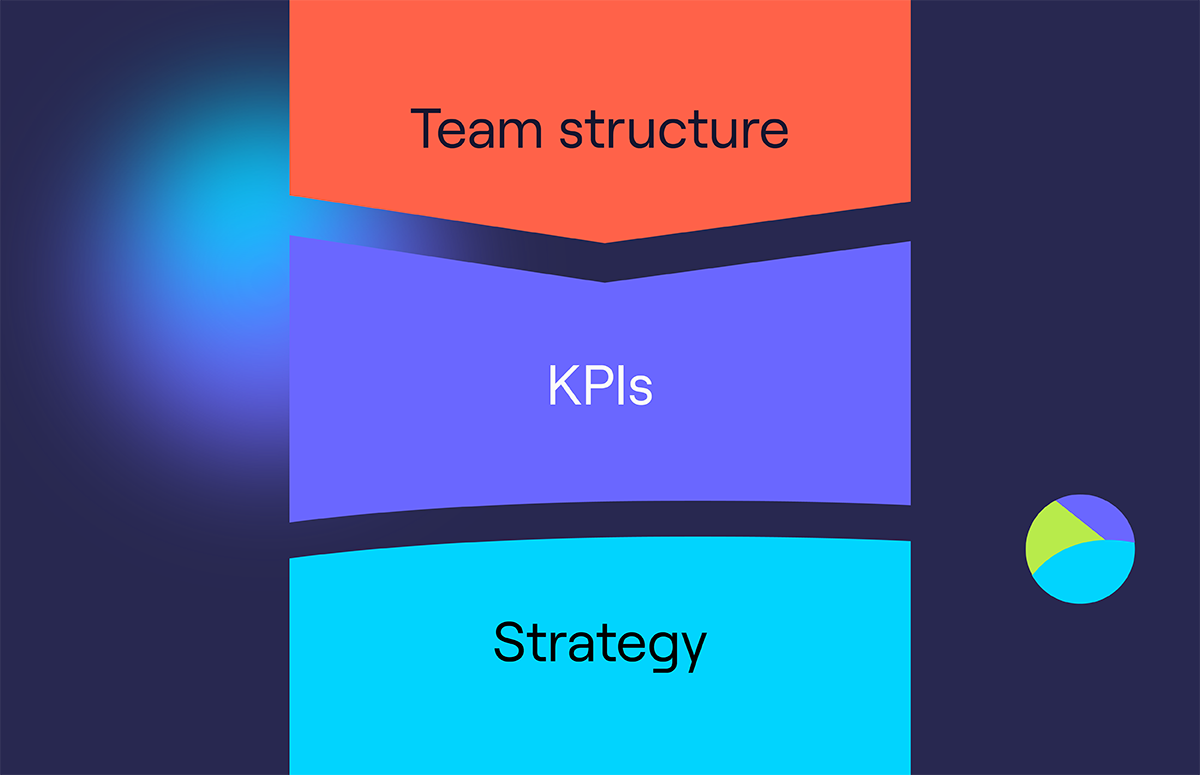8 RevOps Best Practices for Driving Revenue Growth
The biggest revenue operations enhancements often come from experimentation, using real-world data to uncover what works best for your B2B company and then doubling down on that.
But that doesn’t mean we can’t get a leg up with a few quick wins or use tried-and-true tactics that other companies have already benefited from.
It’s a good idea to base your RevOps strategy on established principles that work well and then customise it as you collect information on what works (and what doesn’t) at your company.
In this article, we’ll explore eight essential RevOps best practices you can implement immediately to improve your revenue team’s efficiency and effectiveness.
For each of the eight RevOps best practices, we’ll discuss their importance, how they impact core business goals like revenue growth and operational efficiency, and share tips for implementing them.
1. Create alignment across the three revenue teams
One of the principal goals of nearly every RevOps leader is to improve alignment across the three revenue teams: namely marketing, sales, and customer success.
These teams have traditionally been disconnected and siloed off from one another. This often leads to disjointed customer interactions and internal conflicts between team-specific goals.
By focusing on the teams’ alignment toward shared objectives and enhancing collaboration, you’ll create a more cohesive customer journey, reduce friction during handoffs, and improve efficiency across the revenue funnel.
Here are a few ways you can improve alignment between sales, marketing, and customer success functions:
- Established unified goals. Instead of each team working toward its own performance metrics, roll out shared KPIs that all three teams contribute to, such as revenue, pipeline growth, or retention rates. Ensure each team understands how their actions contribute to these common goals.
- Hold regular alignment meetings. Host cross-team syncs to review goals, metrics, and strategies. Drill into examples of effective collaboration between teams that won deals or otherwise improved revenue.
- Integrate collaborative tools. Use shared platforms (such as CRMs or customer communication tools) to reduce data siloes and improve cross-team collaboration.
Improve alignment between your three teams, and you’ll drive revenue growth through faster sales cycles, better customer retention, and internal efficiency.
2. Leverage quality data to improve decision-making
Quality data is the backbone of the revenue team.
Without accurate prospect data, sales can’t effectively tailor their messaging or identify potential customers who are ready to buy.
Without up-to-date insights on buying behaviours and objections, marketing can’t effectively set up targeting parameters.
Without information about objections during the buying process or the prospect’s use case, the customer success team can’t formulate a personalised strategy for retention and account growth.
By improving data quality, you can better identify trends and track performance. You can make informed decisions about territory planning and targeting. You can also minimise wasted time on correcting, validating, and replacing faulty data points.
Strategies for improving data reliability across the entire organisation include:
- Implementing a data quality checklist and audit process.
- Using a data enrichment tool like Cognism to regularly update stale data and automatically enrich incoming leads.
- Integrate buyer intent data to help sales capitalise on hot buyers.
- Implementing a centralised data repository (such as the CRM) that all parts of the RevOps tech stack plug into, thereby aligning data across teams.
- Automate data cleansing to remove duplicates and keep your data set lean and accurate.
By making data quality a core focus, you’ll ensure a healthy sales pipeline and effective marketing campaigns. Your revenue potential will skyrocket!
👉 Cognism is built for revenue teams that want to improve their pipeline and manage their resources. See how our quality data will fuel your funnel.
3. Streamline and standardise processes
If there’s one thing nearly all RevOps leaders are obsessed with, it’s efficiency.
That’s why one of the most critical revenue operations best practices is streamlining and optimising your processes.
This means creating repeatable workflows to ensure consistency, using automation to reduce errors and inefficiencies, and streamlining customer handoffs between teams.
Key areas to focus on here are:
- Process mapping. Document existing workflows, look for inefficient ones, and redesign your revenue operations processes. Distribute the new documentation, create training plans, and monitor behaviour to ensure workflows are followed.
- Implementing automation. Many tools in your tech stack already have automation features, such as Cognism’s automated data enrichment. Go a step further and use a dedicated workflow automation tool like Zapier to connect platforms that don’t offer native integrations or are limited in their implementation.
- Smart lead scoring and routing. Leverage modern AI tools to improve your lead scoring and routing capabilities. This will help your sales team work more effectively, improving speed to lead.
- Streamlined sales enablement. Build automated playbooks, objection-handling materials, and battle cards for quick reference. Team up with your content team to produce effective sales enablement materials, aligning messaging with marketing efforts.
- Hand-off processes. Trigger alerts to customer success teams when deals are closed. Set up protocols for data sharing, such as translating Gong recording transcripts of your sales calls into actionable insights for your CS team.
By standardising and optimising revenue team workflows, you’ll reduce human error, eliminate bottlenecks, and create a more consistent customer experience.
4. Implement a continuous development program
Revenue operations involves more than software tools, data, and effective processes. It also requires a skilled, customer-focused team that understands the importance of collaboration.
One of the most important RevOps best practices to implement is an ongoing training and professional development program for your revenue team members.
Your training plan should be broad, including:
- Keeping abreast of new tools and technological developments.
- Constantly reviewing competitors’ strategies.
- Opportunities for feedback and suggestions.
- Cross-team training, such as customer success learning sales skills or sales learning about account-based marketing.
There are several ways to deliver this training. Workshops and formal training sessions are a good start, especially when coupled with one-to-one coaching.
You might also consider incorporating a mentorship program in which junior members are paired with experienced colleagues for observation and on-the-job learning.
5. Track performance and goals
They say that what gets measured gets optimised. But it’s also true that the more closely you measure a given metric, the more attention you put into optimisation.
That’s why it’s vital to set predefined KPIs and track performance and progress toward them regularly (monthly, in most cases).
You’ll want to do this at the organisational, team, and individual levels. For example:
The whole revenue organisation is measured on revenue growth, the sales team is measured on new deals closed, and individual sales reps are measured on KPIs such as opportunities created.
Some practical tips for implementing performance tracking include:
- Using tools like Tableau or Looker to build personalised dashboards. These allow you to visualise key metrics in real-time and automate updates, such as Monday morning email reports.
- Ensuring individual goals ladder up to team and organisational goals so that employees understand their role’s impact.
- Using predictive analytics to forecast revenue outcomes based on current and historical pipeline data.
By focusing on performance tracking, you’ll hold individuals accountable for their contributions while helping teams identify and replicate winning strategies.
6. Optimise revenue forecasting accuracy
Forecasting is integral to revenue operations, but it’s only useful if your forecasts are accurate.
To improve forecast accuracy, you’ll need to ensure your predictive analytics tool has access to real-time historical data, such as deal win rates, pipeline velocity, and the number of active opportunities you have in your CRM.
Strategies to implement here include:
- Improving the strength of data integrations.
- Gathering input from your finance, sales, and marketing teams to align assumptions and prevent silos.
- Increasing pipeline accuracy with intent data.
- Accounting for external factors like economic conditions and competitor moves.
- Developing forecasts under different assumptions to plan for different scenarios.
Accurate forecasts facilitate more effective financial planning, resource allocation, and strategy development. They set you on the path to sustainable growth, which is a key part of RevOps success!
7. Integrate customer success
Technically speaking, revenue operations encapsulates three teams: sales, marketing, and CS.
Practically, however, RevOps all too often focuses on new customer acquisition (sales and marketing) and neglects the fact that retaining customers is critical for revenue growth, especially in subscription and recurring revenue businesses.
The best RevOps teams position customer success as a core part of the revenue engine, not just a support role. They put a focus on churn mitigation, customer advocacy, and identifying upselling opportunities.
These vital strategies increase a customer’s lifetime value and improve your ability to generate referrals, which directly impact revenue growth.
To put a stronger focus on CS as a revenue driver, here are some strategies to implement:
- Aligning customer success metrics (e.g., NPS, renewal rates) with your RevOps metrics.
- Using tools like customer health scoring to anticipate issues rather than working reactively.
- Leveraging modern AI solutions to track customer churn signals, empowering you to act to prevent losses.
- Developing feedback loops that allow you to gather and act on customer feedback regularly.
- Design upselling and cross-selling strategies and encourage collaboration between sales and CS.
8. Adopt a customer-centric focus
Our final RevOps best practice is to prioritise customer satisfaction, working on the presumption that if you achieve this goal, revenue success will follow.
This involves ensuring processes are designed with the customer journey in mind. You must always seek to remove friction for your customers rather than focus on what’s best internally. It also involves investing in personalisation, even if it might mean slightly slower responses or a higher CAC.
Your biggest win here will be to develop a culture of asking the question, “What does this look like from the customer’s POV?” before making any changes to your business strategy.
The positive impact on revenue from adopting this best practice comes from:
- Higher satisfaction and retention rates.
- Lower friction during the sales process and higher conversion rates.
- Satisfied customers who are more likely to refer, recommend, and provide positive testimonials or take part in a case study.
Transform your RevOps strategy with best-in-class B2B data
Each of our eight RevOps best practices can make a measurable impact on revenue growth, team efficiency and collaboration, and the customer experience.
In particular, improving data quality through automated enrichment, regular cleansing, and enhanced connections across your tech stack will help you:
- Drive more informed decisions.
- Plan and strategise more effectively.
- Save time on chasing up redundant phone numbers and emails.
Cognism’s powerful and compliant B2B data can be the fuel for your revenue operations engine.
With our data enrichment, cleansing, and AI-powered prospecting tools, you can gain clarity on your TAM, plan territories more effectively, and give your sales reps hours back to do what they do best.
/Lead%20routing%20tools/lead-routing-tools-resource-card.webp)

